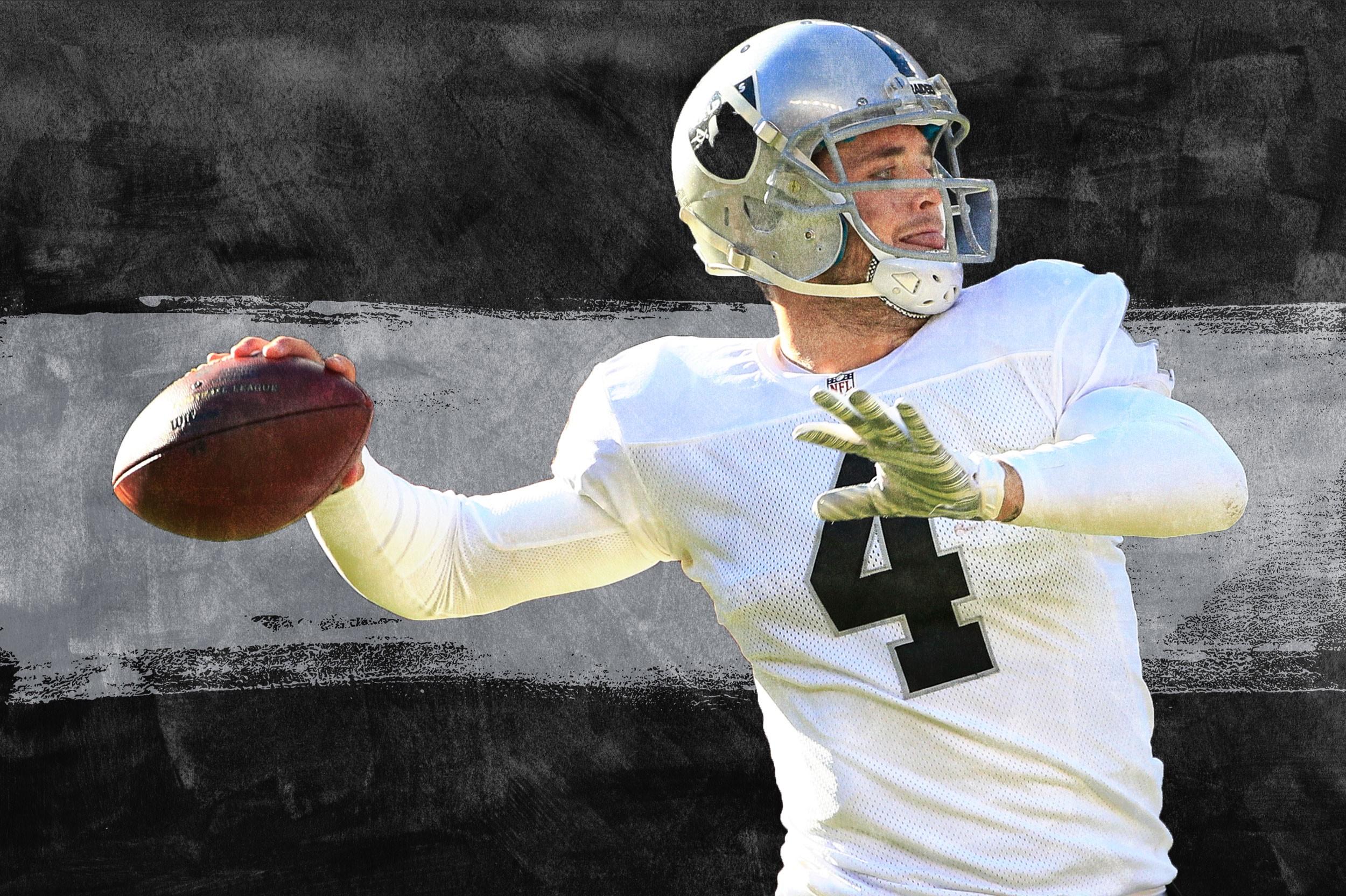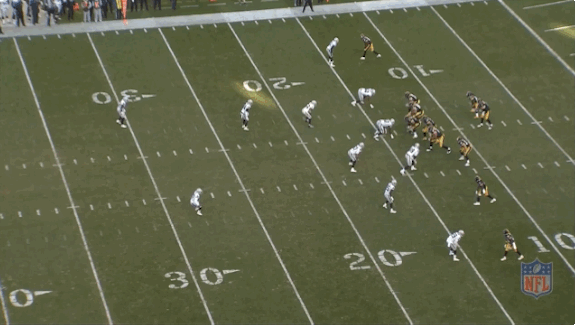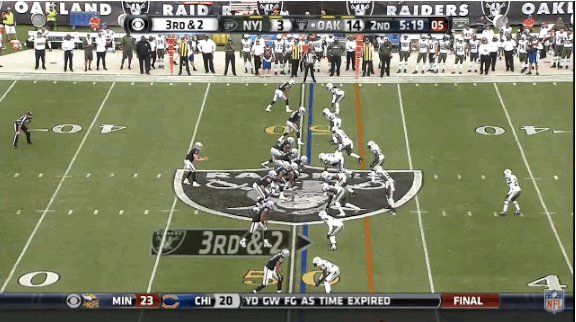
Idyllic Napa, California, has been home to the Raiders’ training camp for 20 years, but when coach Jack Del Rio’s players arrived there last week, they might have felt like strangers in a strange land. In a way, the silver and black are now neighbors with the Ravens, Texans, Colts, and Chiefs — teams that Vegas projects to finish around .500, teetering on the brink of playoff contention. Oakland and Baltimore share an over-under win total: 8.5. A child born during the last season the Raiders topped eight wins would be taking algebra and hating his parents by now. The Ravens have done it seven times over the past 10 years.
Oakland’s hype train has been barreling down the tracks in recent months, to the point that it almost feels too good to be true. Offseason champions and preseason darlings have historically generated mixed results, and the Raiders have landed both of those titles in 2016. Coming off a seven-win season and a load of prized free-agent signings, it’s easy to understand the optimism. But before we label Oakland as a contender in a division with the defending Super Bowl champs and a Chiefs team that’s made the playoffs in two of the past three seasons, it’s worth analyzing the Raiders’ roster on both sides of the ball to determine whether the excitement is justified.
The Defense
Any case for the Raiders reaching their 2016 ceiling should start with Khalil Mack. The third-year edge rusher (that’s his position; let’s stop with this linebacker–defensive end hybrid nonsense) is already among the five best defenders in football and has the type of talent to sabotage any given play. After proving to be an absolute nightmare against the run as a rookie, Mack closed the razor-thin timing gap between a four- and 15-sack total in his second season, just like we all knew he would.
As a group, though, the most glaring thing about the Raiders’ defense is just how much turnover there’s been. Not a single one of their projected starters on this side of the ball was even on the roster before 2014, and an insane number of them arrived in 2015 and ’16. Mack, nose tackle Justin Ellis, and corner Travis Carrie were all drafted by Oakland two years ago; they’re already the longest-tenured members of the expected starting 11.
The first influx of talent, combined with Mack’s ascension to a plane somewhere above the rest of humanity, helped the Raiders jump from 26th in defensive DVOA in 2014 to 15th last season. This spring’s free-agent haul has been pegged as the turning point for Oakland luring veterans, but in terms of both pedigree and return, the defenders added in 2015 shouldn’t be forgotten. Defensive tackle Dan Williams was a beast against the run in his four years starting with the Cardinals, and that continued last fall in the first season of his four-year, $25 million deal with the Raiders. Perhaps the most surprising contributor to Oakland’s defensive improvement — and maybe the most surprising story of the entire NFL last season — was cornerback David Amerson, a former second-round pick cut by Washington after its Week 2 win over St. Louis, who was then signed by the Raiders, became an immediate starter, and earned a four-year deal with $18 million guaranteed in July. He’s far from this unit’s most important piece, but his emergence has been key. This is how the perception of a franchise changes, when careers get resurrected there, rather than destroyed.

Success stories likes Williams’s and Amerson’s helped make Oakland a more attractive free-agent destination, and this offseason, armed with a sea of cash, general manager Reggie McKenzie lured the cavalry to town. The major renovations came in the secondary, where former Bengals standout Reggie Nelson, consistently among the best safeties in the league, got a two-year deal worth $8.5 million. The Raiders gave a four-year, $38 million contract to cornerback Sean Smith, a 6-foot-3 veteran who spent most of the past three years showing off his man-coverage skills in Kansas City, and then grabbed West Virginia safety Karl Joseph with the no. 14 pick in the draft. Joseph, who intercepted three passes in one quarter of a game against Georgia Southern last September, likely would’ve gone earlier had he not torn the ACL in his right knee four weeks into his final college season. In Nelson, Smith, and Joseph, Oakland has a quality center fielder, a condor-size cover corner, and a heat-seeking missile, respectively. They should add to a diverse group of skill sets in coordinator Ken Norton Jr.’s secondary, and they represent a massive upgrade from what this defense trotted out in 2015.
To aid the pass defense even further and round out the Raiders’ free-agent spending spree, McKenzie inked former Seahawk Bruce Irvin to a four-year, $37 million deal with $19 million guaranteed in March. On the surface, that seems like a lot of money to give a guy who recorded 5.5 sacks last year, but since his second season in Seattle, Irvin’s shift to linebacker has meant both fewer pass-rushing opportunities and the adoption of a completely different mindset. In Oakland, his role should be streamlined. He’ll line up opposite Mack, in the spot vacated by Aldon Smith, and will be tasked with disassembling QBs. That’s what Irvin does best, and he’ll have the chance to do it all the time.
Mack and Irvin should make for a formidable one-two combination off the edge, but the pass-rushing prospects elsewhere along the defensive front aren’t quite as exciting. It’s easy to envision last year’s ultratalented, second-round pick Mario Edwards taking a step forward after he tallied only two sacks as a rookie. Right now, he’s the most promising option for Oakland generating pressure inside. Looking at the construction of this defense, the Raiders’ free-agent pursuit of Malik Jackson this spring makes perfect sense. They needed a pocket-pushing force to pair with Mack and Irvin; now, they’ll have to rely on Edwards and 2016 second-round pick Jihad Ward.
Overall, the middle of the Oakland defense is the biggest cause for concern — and that goes beyond the interior pass-rushing options. The Raiders’ linebacking corps, where Super Bowl XLVIII MVP Malcolm Smith and 2015 fifth-round pick Ben Heeney are slated to start, is the weakest position group on the roster. But the real issue Oakland must contend with is depth. McKenzie’s 2014 draft haul looks like a home run worthy of a José Bautista–like bat flip, but the Raiders’ drafting sins of the not-so-distant past have left the roster without much talent outside of their past two draft and free-agent classes. Unless former project and 2013 second-round pick Menelik Watson can unseat Austin Howard at right tackle, running back Latavius Murray will be the Raiders’ only pick taken between 2010 and 2013 who is slated to start on offense or defense this year.
Few teams can afford injuries to their stars, but that lack of depth makes it paramount for Oakland to avoid them. If Mack (or Williams or Nelson) were to go down, it could spell disaster for a promising-if-unproven group. The new additions have made every level of this defense better, and the secondary especially so. If the starting unit stays healthy, there’s almost no reason to believe that the Raiders’ defense won’t be vastly improved.
The Offense
Mack is the Raiders’ true full-fledged star, but the franchise’s first real glimmers of hope shined through last season when quarterback Derek Carr was slinging the ball all over the field. Plenty of bad teams have featured All-Pro pass rushers; very few have been led by great quarterbacks, and by last October, it seemed Carr might be on his way to reaching that point.
Falling in love with Carr’s game is easy. His arm rivals anyone’s in the league, and on days when he really has it going — like his 23-of-36, 333-yard, four-touchdown outing in a win over the Jets last November — it’s a sight to behold. It’s also what might’ve caused some people to get a little carried away with their evaluations of him last year. Carr had several brilliant performances during the first half of the 2015 season, a stretch in which he completed 63.7 percent of his passes and threw for 19 touchdowns against just four interceptions. In the second half of the season, though, things got a little dicey. Carr’s completion rate dipped to 58.7 percent in his final eight games, and he failed to crack an average of 6.0 yards per attempt in any of his final five starts. Those are the type of numbers we saw from him as a rookie.

The book on Carr coming out of Fresno State — a quarterback with an incredible arm, but someone who struggles (even more than other QBs) when pressured — has more or less played out, only with the equation shifted in Carr’s favor. He’s a better passer than most expected, and his issues operating in a muddled pocket haven’t been his downfall; they’ve merely held him back. Having space and time to work is vital to Carr’s success, and whether it was with play design or the direction and depth of his drop, the Raiders did all they could last season to give him both. It helps that they had the best pass-blocking line this side of Dallas.
Carr faced pressure on just 20.5 percent of dropbacks last year, according to Football Outsiders, good for 32nd out of 37 qualified quarterbacks. Unlike the Cowboys and their collection of first-round picks, Oakland has assembled its line via different avenues. Guard Gabe Jackson is a homegrown, borderline star, but incumbent right tackle Howard came over after inking a five-year, $30 million deal in 2014, and center Rodney Hudson arrived by signing a five-year, $44.5 million contract in ’15. Then there’s tackle Donald Penn, who was taken off the scrap heap after being cut by the Bucs in March 2014 and has been consistently reliable the past two seasons in Oakland. He agreed to a two-year, $11.9 million deal to stay with the team this spring.
The Raiders’ line was excellent in pass protection last season, but one element was missing: an ass-kicker up front, a truly nasty presence who could breathe life into a running game that finished 24th in the NFL in offensive DVOA in 2015. Kelechi Osemele is that ass-kicker. Oakland made the former Raven the richest guard in football this spring, giving him a five-year, $58 million deal that includes $25.4 million in guarantees. Osemele brings value with his experience at tackle, but he’s at his best on the inside, where he can wipe defenders from the face of the planet. We saw what one mauling, physical guard could do for an entire offense’s mentality last year, when the Cardinals signed Mike Iupati and jumped from 30th to 16th in rushing DVOA. The Raiders could make a similar leap this fall, and the bevy of contests in which Murray was DOA (he had five games in 2015 that he averaged 3.0 yards per carry or less) could quickly become a thing of the past.
If the running game adds a little more pop and the Raiders keep Carr upright, this unit has the weaponry to take another step forward. Receiver Amari Cooper dropped the ball too often as a rookie, but he also offered plenty of flashes to prove why he was worthy of going no. 4 overall in the 2015 draft. He finished last season with 1,070 yards and six touchdowns, and clearly has the makings of a future star. And it’s a bonus that Cooper’s playmaking ability pairs nicely with the reliable, resurgent Michael Crabtree’s skill set. The Raiders would have been well served to add another quick-strike element to their 2016 offense, preferably a second option to push Murray in the backfield, but they elected to go with a contingency plan at QB. They took Connor Cook, which is weirdly forgettable, in the stretch of this year’s draft when guys of that ilk are available.
Oakland is hoping that tight end Clive Walford, now in his second season out of Miami, can up the 28 receptions he tallied last season. But for now, the cause for Raiders’ optimism rests in the continued development of young players across the offense — and the much-needed physicality of Osemele. That might be enough. Given their depth, these Raiders have very little margin for error, but there’s a lot to like about their projected 22 starters. If Carr looks more like the quarterback he did in the first half of last season than the second, Oakland pushing past the Broncos and Chiefs in the AFC West is a real possibility.